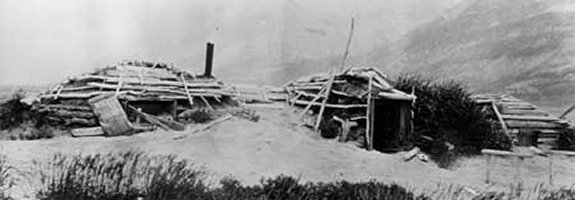Bristol Bay Cultures & History

Native People of Bristol Bay… A Cultural Mix
Eskimos, Aleuts, and Athabascan Indians used this area of the Naknek River during the past 6,000 years. There are numerous archeological sites, hunting camps, old villages and evidence of use along the river and its tributaries. Old Savonoski, on Savonoski River at the east end of Naknek Lake, and New Savonoski and Paugvik on the Naknek River are all abandoned village sites. The original Eskimo village at Naknek went through various names as recorded by the Russians after they arrived in the area in 1819 (1821-“Naugeik”; 1880- “Kinuyak”; and finally Naknek as named by Russian Navy Captain Tebenkov).
The Russians built a fort at the site of present day Naknek and fur trade was an economic use of the area for a while. In 1883 the first salmon cannery was open in Bristol Bay; then, in 1890, one opened on the Naknek River, and a fishery related economy has been the mainstay since that time. The influence of the Katmai Volcano Explosion in 1912 and the influenza epidemic in 1919 nearly decimated the Naknek people and area. According to oral history there were only about three original families left at that time.
The Russian Orthodox Church was the first entity to obtain land under the U.S. Government after the Treaty of Cession in 1867. Under the Homestead Act, the Russian Church obtained title to much of the ground that currently comprises Naknek. They provided lots to residents who built around the Church. The canneries and fishing industry drew many residents from other Alaska Native villages, and from fishing communities and countries creating a mixing of cultures built upon the returning salmon.
This mixing of peoples involved in the fishing industry has caused the communities to be comprised of an international culture in many ways. The result is an almost unique culture of the Bristol Bay Borough composed of about 52% non-native and the other 48% a mix of Alaska Native cultures. The economy is based on government employment, salmon fishing and processing. Naknek has a seasonal economy as a service center for the huge red salmon fishery in Bristol Bay. 122 residents hold commercial fishing permits, and several thousand people typically flood the area during the fishing season. Millions of pounds of salmon are loaded onto ships, or trucked over the Naknek-King Salmon road each summer for transport to market. -- Naknek Native Village CouncilHistorical Milestones
The Russian Era
Russian exploration of Bristol Bay may have occurred as early as 1791 when Dmitry Bocharov crossed the Alaska Peninsula in the vicinity of the lake that now bears his name (in slightly modified form – Becharof). But exploration did not begin in earnest until 1818 with an expedition led by Petr Korsakovski. The Russians built a fort at present day Naknek and fur trade was an economic use of the area for a while. The most lasting legacy of the Russian era is the Russian Orthodox religion. The first chapel was constructed in the 1870s. A tiny later chapel can be found behind the Bristol Bay Borough building surrounded by a small cemetery with the distinctive Russian Orthodox crosses.
The American Period
In 1867, after the purchase of Alaska by the United States, the San Francisco firm of Hutchison, Kohl and Company purchased the assets of the Russian-American Company. It was later reorganized to form the Alaska Commercial Company, which operated until the end of the 19th century.A commercial development in Bristol Bay that had a greater and more lasting effect on the people of this region than the fur trade was the salmon fishing industry. In the Naknek River region commercial fishing began in the early 1890s when salteries were established a short distance above the river’s mouth. In 1894 the first cannery was constructed. Today there are 6 canneries along the Naknek River and commercial fishing still plays a primary role in the economy of the area. To arrange a guided tour and learn more of the history of the area, see the Tours listing .
1912 Eruption
Life forever changed on June 6, 1912 for those living in the shadow of Mt. Katmai. Forewarned by the jolting and rumbling of the earth for several days before the colossal explosion, many Natives fled their villages. Although the eruption was the most voluminous volcanic eruption of the twentieth century, few people witnessed it and, miraculously, nobody was killed or hurt.The ash cloud from the eruption darkened the sky over Kodiak, blotting out all daylight. When the ashfall finally dwindled on the morning of June 9th, Kodiak had experienced two days and three nights of nearly unbroken darkness and the island was cloaked under gray drifts of ash several feet thick.The sound of the eruption was heard in Juneau, 750 miles away and in Fairbanks 500 miles northeast. Two feet of ash covered an area of 2,500 square miles and dust fell in Puget Sound, 1,500 miles away.In 1916, Robert F. Griggs led a National Geographic expedition over Katmai Pass and saw, for the first time, the Valley of Ten Thousand Smokes. Two years later, the area was designated Katmai National Monument.
WWII
In 1941, at the beginning of World War II, the U.S. built an air base in King Salmon. The base was a major military installation in western Alaska. Although the air base was self contained, the village grew up around it. In 1949, a post office was established and the U.S. Army Corps of Engineers constructed a road to Naknek. In 1993, the Air Force Station went into caretaker status, but periodic military activities still occur here. Today, the state-owned airport with its 8,500-foot paved runway has allowed King Salmon to develop into a government, transportation and service center.
Source: Bristol Bay Visitor Guide
For more information download the full printable Visitor Guide and Business Directory
